Hi y'all. It's August, we're smack in the middle of the dog days of summer and…as you would expect….the dogs are barking their loudest. My science fiction book's done, so now I'm left with one minor problem. How do I catch up on everything I let slide for the last several months while the book (and a couple of desperation custom built models) dominated my every waking moment. About all I know to do is start. When I'll get caught up is anyone's guess, but if I don't start, I'll never finish. So…….. 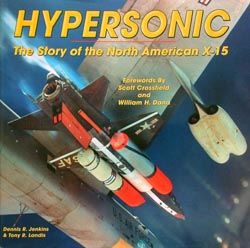 Several months ago, I briefly mentioned a new book from SPECIALTY PRESS called Hypersonic: The Story of the North American X-15 by Dennis R. Jenkins & Tony R. Landis. Price was listed at $39.95. Basically, what I said was that you could wait for the review or go ahead and buy it without any qualms. For those of you who waited, here's the review. Several months ago, I briefly mentioned a new book from SPECIALTY PRESS called Hypersonic: The Story of the North American X-15 by Dennis R. Jenkins & Tony R. Landis. Price was listed at $39.95. Basically, what I said was that you could wait for the review or go ahead and buy it without any qualms. For those of you who waited, here's the review.
If you've so much as glanced at a SPECIALTY PRESS catalog or their website, you'd have to be blindfolded not to be familiar with the range of quality aviation history publications produced by these two authors. They're right up there with the best of them and this book simply helps secure that reputation. What kind of book is it? A 10" x 10" hardback with 276 pages, 500 b&w photos, 50 color photos and 100 drawings. The format is essentially identical with Dennis R. Jenkins' earlier masterpiece on the B-36 called Magnesium Overcast. Between the covers of this book is enough material to keep me describing and gushing for several thousand words…but I'll try to be brief. It starts with a foreword by Scott Crossfield (who made the first X-15 flight) and another by William H. Dana (who made the last X-15 flight). There's also a four-page preface that include direct comments from both Jenkins and Landis. And on the fourth page, you'll also find a little shaded box announcing a companion volume called the X-15 Photo Scrapbook with another 400 photos. Now available, we'll deal with that one following this review. Chapter One deals with early history and takes you through the successful breaking of the sound barrier by Chuck Yeager, then Chapter Two moves the reader into a new area…hypersonic flight. Chapter Three discusses Project 1226 in detail and things really begin to get interesting. There's the usual jockying as companies compete against each other, but particularly fascinating are the different designs proposed by Bell, Douglas, North American and Republic. The Douglas concept is more than a little strange looking, especially in the artist's concept. On the other hand, I find the Republic version fascinating because it apparently was based on that incrediably futuristic Mach-3+ XF-103 that still enthralls me. No matter, North American won the competition and they were off to the races. From Chapter Four on, the book deals with the X-15 basically as we have come to know it. Construction photos, wind tunnel tests, unexpected problems, escape system, the test range, the various dry lakes and on and on and on. You'll find information on many of the flights, the ventral fin, cockpit photos and more. Two chapters should really have modelbuilders salivating even more than the rest of the book will. Chapter Six deals with the X-15's carrier and support aircraft, including a dandy 3-view drawing showing how the X-15 would have been carried by the B-36. Believe it or not, the B-58 and KC-135 were also considered before the B-52 was chosen. The wildest and most improbable idea of all was using an XB-70 as a carrier aircraft to launch a proposed delta-wing X-15 from it's back while the XB-70 was moving at Mach 3! Think I'm kidding? Page 76 reproduces a b&w artist's concept of exactly that proposal. For those whose interests lie in the unusual, unique, improbable and/or downright impossible aerospace concepts, you're gonna love Chapter Twelve. What would you say to an X-15 mounted on top of a cluster of four Titan boosters? Or a two-seat X-15B boosted into orbit or sub-orbit by three Navaho boosters? Or an X-15 mounted on top of a Saturn 1 booster (!). Then there was the thin delta wing X-15 that nearly turned into a real project. Finally, there was the truly radical scramjet-powered delta wing X-15, complete with retractable canards in front of the engine intakes. They called it an X-15, but about the only thing recognizable as an X-15 was the canopy. Last, but certainly not least, are four appendices that give you just about all the facts on the X-15 program that you could ever hope for. Appendix A gives you selected biographies of those who flew the bird or were instrumental in the program. Interestingly, Neil Armstrong (the first man on the moon) flew the X-15 for 20 months. Appendix B is the Flight Log and runs to 25 pages of fine print. Need I say more? Appendix C deals with Notes And Citations and consumes another 11 pages of fine print. Either keep your bifocals handy or don't lose track of your Opti-Visor. Appendix D is a three-page index. 'Nuff said. If you have even a vague interest in the X-15 or have wondered what goes on in the course of an X-Plane project, this book is an absolute must. Save your pennies or ruin your credit card. Whatever it takes, it's worth it.
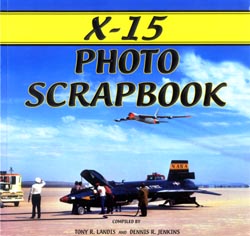 Remember I mentioned a companion volume to Hypersonic? Well, here it is: X-15 Photo Scrapbook compiled by Dennis R. Jenkins and Tony R. Landis. Price: $16.95. It runs to 108 pages, utilizes a 9" x 9" format and is a softcover publication. Inside, you will find 350 b&w photos and 50 color photos. Remember I mentioned a companion volume to Hypersonic? Well, here it is: X-15 Photo Scrapbook compiled by Dennis R. Jenkins and Tony R. Landis. Price: $16.95. It runs to 108 pages, utilizes a 9" x 9" format and is a softcover publication. Inside, you will find 350 b&w photos and 50 color photos.
There's little point in describing this book in depth. That'd ruin the fun for you. It's exactly what it says it is…a photo scrapbook of the X-15. Some of the photos have no captions at all, others have very lengthy informative ones, but it's the photos themselves that take center stage. If you've already bought or are planning to buy (And if not, why not?) Hypersonic, you'll need this scrapbook as well. You'll regret it if you don't.
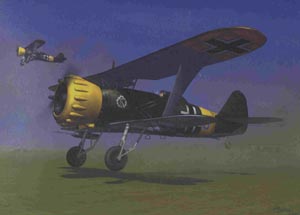 If you're looking for another Luftwaffe aircraft to add to your 1/48th scale WW-II collection, AMtech Models has one that you really shouldn't overlook. Especially if you like to build models that are a little out of the ordinary instead of another Bf-109, FW-190 or Stuka. What would you say to a Henschel Hs-123A? What! A biplane? Exactly so…and a real dandy, too. If you're looking for another Luftwaffe aircraft to add to your 1/48th scale WW-II collection, AMtech Models has one that you really shouldn't overlook. Especially if you like to build models that are a little out of the ordinary instead of another Bf-109, FW-190 or Stuka. What would you say to a Henschel Hs-123A? What! A biplane? Exactly so…and a real dandy, too.
Those of you who've been building models for more than a year or two are probably saying "Wait a minute. Didn't ESCI do an Hs-123 kit many years ago?" That they did and that's exactly what this kit is, but improved to a fairtheewell. This fits the AMtech philosophy to a T. If no kit exists, they'll create one from the ground up. However, if a decent-to-good kit of the subject exists, they'll repop it (legally, of course) with additional detail parts. Not only does this make it better, you have the option of creating a variant or variants that you couldn't before. That's the case here. The original ESCI kit comes fully bagged. In fact, there are four bags inside a fifth bag but you're going to be sharp-eyed to spot the fourth bag. That's because it holds nothing but that very small windscreen. So be very careful when removing all the parts from their outer bag. Believe me, it's real easy to lose that windscreen bag since it's all of an inch-and-a-half square. I nearly stepped on it before I found it! Two other small bags are in the box, one containing all those beautiful Black Box resin parts for the cockpit and the other holding totally new styrene parts so you can build this little beauty with unspatted landing gear. If you plan to put it in Russian Front markings, you want to seriously consider this option. In that Russian quagmire, otherwise known as mud, an unspatted Hs-123 could get off the ground when nothing else stood a chance. Quality of this kit when originally released by ESCI was state-of-the-art for it's time and it holds up well even today. Detailing is very delicate, though panel lines are raised instead of recessed. However, they're so beautifully done that you certainly have no reason to gripe about it. Control surface lines are recessed as you would expect. 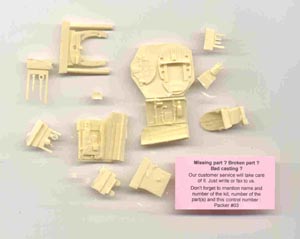 The newly tooled parts for the unspatted gear are both beautiful and delicate. You get four yokes and two main struts (which look like biplane N-struts at first glance)…two yokes and one strut for each gear. And a total of 17 resin parts make up the cockpit interior, some of'em so small that you'll need both your Opti-Visor and a pair of high quality pointed tweezers to find and handle them. The newly tooled parts for the unspatted gear are both beautiful and delicate. You get four yokes and two main struts (which look like biplane N-struts at first glance)…two yokes and one strut for each gear. And a total of 17 resin parts make up the cockpit interior, some of'em so small that you'll need both your Opti-Visor and a pair of high quality pointed tweezers to find and handle them.
Decals are very high quality and provide markings for five different aircraft, including one in Spanish service in 1945. Finally, there's the instructions, which are an absolute jewel. 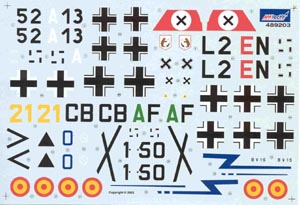
In actual fact, the instructions take the form of a 12-page, 8 1/2" x 11" booklet that's clearer and more detailed than some lengthy magazine articles I've seen. And why can't more kit manufacturers take this approach? Some do, but they're certainly in the minority. These instructions combine very clear illustrations with photographs where needed. All components are clearly identified and there is absolutely no doubt left as to what is to be painted which color…including the fine details inside the cockpit. Due to the fact that resin runs to the brittle side, there is also a very prominent warning to that effect . One thing I especially liked was a photo of all resin parts with a thatched pattern on all of the casting sprues to be removed. This way you don't accidentally get rid of something you need! Two and a half pages are devoted to 4-views of five different aircraft, along with an additional half page of color notes so that you understand why certain aircraft carry the schemes that they do. I could go on and on. Instead, let me summarize the AMtech Hs-123A kit this way: I never got around to building an Hs-123 when it was first released by ESCI. That's an oversight I'll have to correct fairly soon. I'm glad AMtech has provided me with the opportunity to do so. Price for all this enjoyment? $29.98. Incidentally, since AMtech only made 5,000 of these little jewels, they're going fast. When they're gone…and it won't be long…there will be no more. So get one now or forever hold your money!
Years ago, Aurora produced a relatively small-scale kit (1/9th, I think) of The Incredible Hulk. And, of course, The Hulk went the way of all of their kits when Aurora went under…hard to find.
 But now he's back, bigger than ever. This is because POLAR LIGHTS has created a Vintage Reproduction of the original kit thru new tooling and a larger 1/8th scale. They took the same approach with their recent Spiderman kit as well. But now he's back, bigger than ever. This is because POLAR LIGHTS has created a Vintage Reproduction of the original kit thru new tooling and a larger 1/8th scale. They took the same approach with their recent Spiderman kit as well. The kit only has 20 parts, but still takes up every bit of a 7" x 13" x 3" box. If nothing else, it proves that he really is The Incredible Hulk, though it's a very large one-piece base that takes up about half the box. No matter, all the parts are crisply molded from styrene with little if any flash. I would mention color, but since my kit turned out to be one of those 1 in every 12 molded in white, I can't say what color most kits are molded in. Green, I would assume, but don't quote me on that. Sculpting is nicely done with very nice relief around the muscles. Instructions are the usual retro style, but this time around one side is printed in English and the other in French. The painting guide is reasonable, but I'd suggest that anyone interested in making their Hulk stand out will do a lot more than just the basic scheme. In fact, you might want to take advantage of an insert you'll find in the box that offers five issues of Amazing Figure Modeler for the price of four (only $28.00). And I suppose I'd better be politically correct and reiterate the fact that the insert itself states that AFM is recommended for MATURE READERS. All in all, The Incredible Hulk will make for an interesting…and different…addition to your collection of figures. The $18.99 price isn't bad either.
| 








|
 Several months ago, I briefly mentioned a new book from SPECIALTY PRESS called Hypersonic: The Story of the North American X-15 by Dennis R. Jenkins & Tony R. Landis. Price was listed at $39.95. Basically, what I said was that you could wait for the review or go ahead and buy it without any qualms. For those of you who waited, here's the review.
Several months ago, I briefly mentioned a new book from SPECIALTY PRESS called Hypersonic: The Story of the North American X-15 by Dennis R. Jenkins & Tony R. Landis. Price was listed at $39.95. Basically, what I said was that you could wait for the review or go ahead and buy it without any qualms. For those of you who waited, here's the review. Remember I mentioned a companion volume to Hypersonic? Well, here it is: X-15 Photo Scrapbook compiled by Dennis R. Jenkins and Tony R. Landis. Price: $16.95. It runs to 108 pages, utilizes a 9" x 9" format and is a softcover publication. Inside, you will find 350 b&w photos and 50 color photos.
Remember I mentioned a companion volume to Hypersonic? Well, here it is: X-15 Photo Scrapbook compiled by Dennis R. Jenkins and Tony R. Landis. Price: $16.95. It runs to 108 pages, utilizes a 9" x 9" format and is a softcover publication. Inside, you will find 350 b&w photos and 50 color photos. If you're looking for another Luftwaffe aircraft to add to your 1/48th scale WW-II collection, AMtech Models has one that you really shouldn't overlook. Especially if you like to build models that are a little out of the ordinary instead of another Bf-109, FW-190 or Stuka. What would you say to a Henschel Hs-123A? What! A biplane? Exactly so…and a real dandy, too.
If you're looking for another Luftwaffe aircraft to add to your 1/48th scale WW-II collection, AMtech Models has one that you really shouldn't overlook. Especially if you like to build models that are a little out of the ordinary instead of another Bf-109, FW-190 or Stuka. What would you say to a Henschel Hs-123A? What! A biplane? Exactly so…and a real dandy, too. The newly tooled parts for the unspatted gear are both beautiful and delicate. You get four yokes and two main struts (which look like biplane N-struts at first glance)…two yokes and one strut for each gear. And a total of 17 resin parts make up the cockpit interior, some of'em so small that you'll need both your Opti-Visor and a pair of high quality pointed tweezers to find and handle them.
The newly tooled parts for the unspatted gear are both beautiful and delicate. You get four yokes and two main struts (which look like biplane N-struts at first glance)…two yokes and one strut for each gear. And a total of 17 resin parts make up the cockpit interior, some of'em so small that you'll need both your Opti-Visor and a pair of high quality pointed tweezers to find and handle them.
 But now he's back, bigger than ever. This is because
But now he's back, bigger than ever. This is because 







